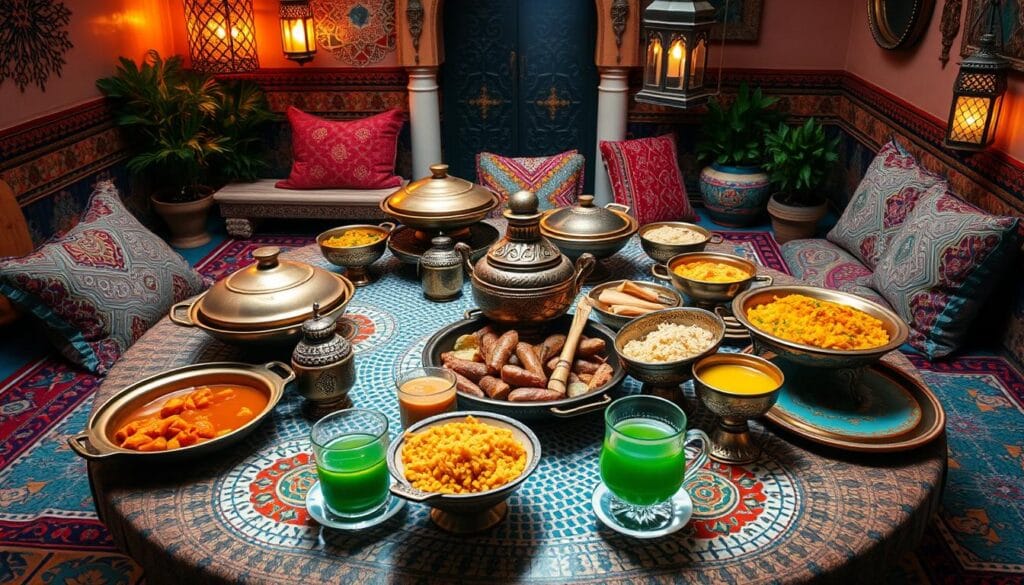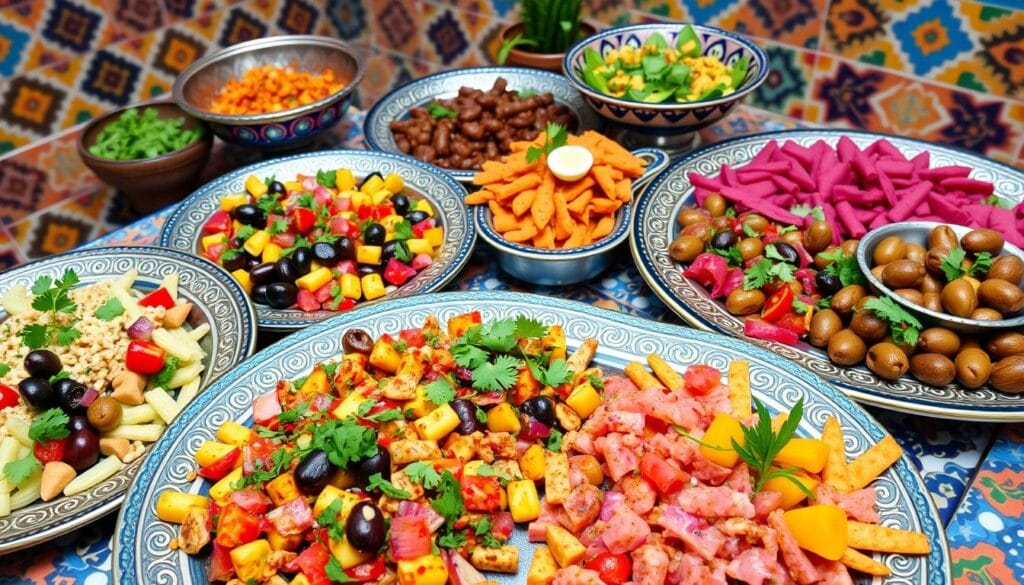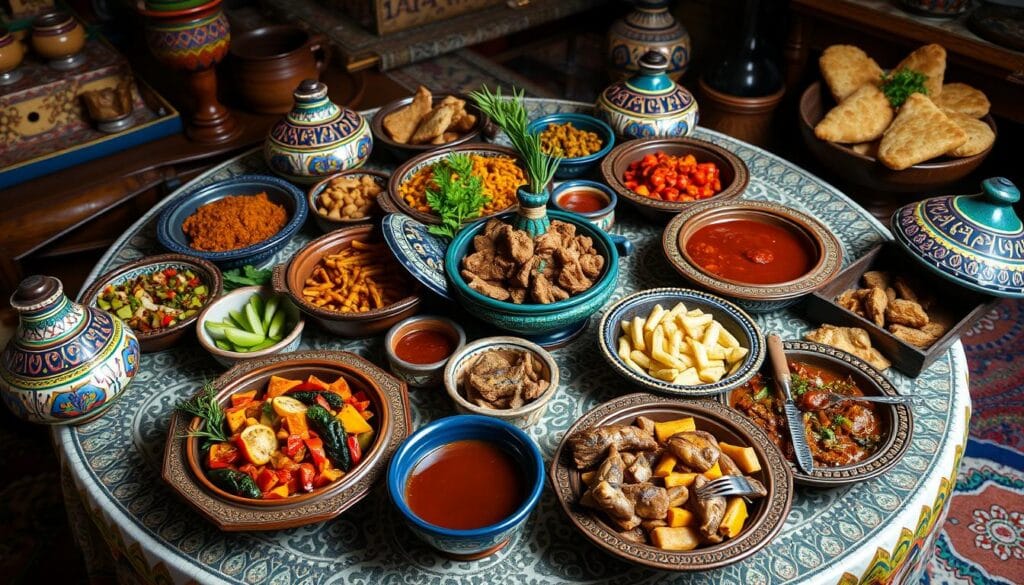10 Best Dishes to Try at a Traditional Moroccan Restaurant
Visiting a traditional Moroccan restaurant is a treat. You’ll find a mix of flavors from Andalusian Spain, Arabia, and France. This blend makes Moroccan cuisine unique. You can try dishes like tagines, couscous, and pastilla.
In a traditional Moroccan restaurant, you’ll find dishes that show the country’s rich culture. From B’stilla to makouda, a deep-fried potato ball, there’s something for everyone. Moroccan cuisine is known for using clay pots called tagines, found everywhere in Morocco.

Exploring Moroccan cuisine, you’ll see how important vegetables are. At least seven vegetable salads are served with bread. Mint tea, or ‘Moroccan whisky,’ is also key. It’s sweet and made with gunpowder tea and fresh spearmint.
Key Takeaways
- Try a variety of authentic moroccan food, including tagines, couscous, and pastilla, at a traditional moroccan restaurant.
- Experience the unique flavors and dishes that make moroccan cuisine so popular, influenced by several cultures, including Andalusian Spain, Arabia, and France.
- Discover the importance of vegetables in moroccan cuisine, with at least seven cooked vegetable salads served with bread.
- Learn about the cultural significance of mint tea, often called ‘Moroccan whisky,’ which is heavily sweetened and typically prepared with gunpowder tea and fresh spearmint.
- Explore the use of traditional clay cooking pots, known as tagines, which is a distinctive feature of moroccan cuisine.
Understanding the Essence of Traditional Moroccan Restaurant Dining
When you try authentic moroccan food, it’s key to know the culture behind it. Traditional Moroccan dining is all about sharing meals and enjoying company. Moroccan dining culture values hospitality and eating together.
In a traditional Moroccan restaurant, you’ll find many traditional moroccan recipes. Think tagines, couscous, and grilled meats. These dishes are served in a way that encourages everyone to share and talk.

Moroccan dining culture is rich in tradition and etiquette. For instance, wait for the host to invite you to eat. Also, always use your right hand when eating or giving/receiving something.
The Role of Communal Dining in Moroccan Culture
Communal dining is a big deal in moroccan dining culture. It brings people together and builds community. In a traditional Moroccan restaurant, you’ll find a friendly atmosphere. People from all backgrounds come to share meals and stories.
The Art of Moroccan Appetizers: Starting Your Culinary Journey
Exploring best moroccan dishes begins with appetizers. Moroccan appetizers are famous for their bold tastes and smells. B’stilla, a flaky pastry with meat, onions, and spices, is a favorite. These dishes are meant to be shared, adding to the fine dining moroccan experience.
Popular moroccan appetizers include zaalouk, a dip of eggplant, tomatoes, and garlic. Taktouka, a mix of roasted bell peppers, tomatoes, and spices, is another hit. Cucumber raita, with Greek yogurt and Moroccan spices, shows the blend of cuisines in Moroccan food.
Other moroccan appetizers are cheese briouat, filled with melted cheese and herbs, and meat briouats, with minced meat and spices. These dishes highlight Moroccan pastry skills and the use of spices for flavor.

Trying different moroccan appetizers is key to enjoying the best moroccan dishes. Each one offers a unique taste and texture. This journey will make you crave more of the fine dining moroccan experience.
Tagine Masterpieces: Signature Dishes of Any Moroccan Restaurant
Tagines are a key dish in Moroccan cuisine, known for their rich flavors. A top-rated Moroccan eatery will offer many tagine choices. These include classic chicken and lamb, as well as vegetarian options.
The Chicken Tagine with Preserved Lemons is a favorite. It combines tender chicken, preserved lemons, and spices. This mix creates a unique and delicious Moroccan taste.
The Lamb Tagine with Prunes and Almonds is another must-try. It features tender lamb, prunes, and almonds in a flavorful broth. This dish is a true delight for the taste buds.
Vegetarian tagine lovers can enjoy dishes like Vegetable Tagine with Preserved Lemons and Olives. Or, try the Chickpea Tagine with Spinach and Garlic. These options let everyone savor Moroccan flavors.

Tagines are a must-try at any Moroccan restaurant or when cooking at home. They offer rich broths, tender meats, and unique flavors. It’s clear why tagines are a beloved part of Moroccan cuisine.
| Tagine Dish | Ingredients | Cooking Time |
|---|---|---|
| Chicken Tagine with Preserved Lemons | Chicken, preserved lemons, spices | 30-40 minutes |
| Lamb Tagine with Prunes and Almonds | Lamb, prunes, almonds, spices | 45-60 minutes |
| Vegetable Tagine with Preserved Lemons and Olives | Vegetables, preserved lemons, olives, spices | 30-40 minutes |
Couscous Creations: The Heart of Moroccan Cuisine
Couscous is a key part of moroccan cuisine, rooted in Berber culture. It’s made from durum wheat semolina. This forms the base of many couscous recipes. When you taste authentic moroccan food, couscous often comes with veggies, meats, and sauces.
In moroccan cuisine, couscous is seen as the national dish. It’s a sign of tradition and family bonding. Some favorite couscous recipes include:
- Traditional couscous with vegetables and meats
- Seafood couscous with shrimp and mussels
- Vegetarian couscous with spices and herbs
Trying authentic moroccan food means experiencing traditional couscous recipes. These dishes have a rich history and cultural importance. Couscous is loved in moroccan cuisine.
In conclusion, couscous is crucial in moroccan cuisine. It offers a unique and tasty experience. Whether you like traditional or modern couscous recipes, there’s something for everyone in authentic moroccan food.
| Couscous Recipe | Ingredients | Preparation Time |
|---|---|---|
| Traditional Couscous | durum wheat semolina, vegetables, meats | 30 minutes |
| Seafood Couscous | shrimp, mussels, spices | 45 minutes |
| Vegetarian Couscous | vegetables, spices, herbs | 30 minutes |
Authentic Moroccan Food: From Street Fare to Fine Dining
Exploring authentic Moroccan food reveals a world of flavors and aromas. Moroccan cuisine, from street fare to fine dining, offers a unique blend. Restaurants like The Spice Souk and Chez Jamal serve the best dishes with a fine dining touch.
In New York City, you’ll find many Moroccan restaurants. They showcase the cuisine’s diversity. Try lamb shank tagine and bastilla at places like Dar Moknine and Aziza. These dishes highlight local ingredients and traditional cooking.
Some notable Moroccan restaurants in NYC include:
- Dar Moknine: Known for its vegetable tagine and traditional Moroccan flavors
- Chez Jamal: Offers a modern take on traditional Moroccan cuisine with dishes like lamb meatball tagine
- Aziza: Features a range of Moroccan dishes, including lamb shank tagine and bastilla
For an authentic Moroccan experience, visit these restaurants. Moroccan cuisine is rich in flavors and aromas. It offers everything from street fare to fine dining, with dishes that will delight your senses.
| Restaurant | Dish | Description |
|---|---|---|
| Dar Moknine | Vegetable Tagine | A traditional Moroccan stew made with seasonal vegetables |
| Chez Jamal | Lamb Meatball Tagine | A modern take on traditional Moroccan cuisine, featuring lamb meatballs in a rich tagine sauce |
| Aziza | Lamb Shank Tagine | A classic Moroccan dish made with slow-cooked lamb shanks in a flavorful tagine sauce |
Sweet and Savory Pastries: Beyond the Main Course
When you visit a top-rated Moroccan eatery, don’t miss out on their traditional pastries. These pastries offer a mix of sweet and savory flavors that are truly unique. The bastilla is a standout, filled with meat, onions, and spices.
Don’t forget to try the traditional Moroccan breads too. They have flaky crusts and sweet fillings. You’ll find favorites like makouda and b’stilla. To make these, you’ll need filo dough, chicken thighs, and blanched almonds. Cooking time is about 1 hour and 30 minutes, with 20 to 25 minutes of baking until they’re golden.
Here are some key ingredients and cooking times for traditional Moroccan pastries:
- 8 whole chicken thighs for the filling
- 4 tablespoons of butter for cooking the chicken
- 1/2 lb of blanched almonds for the almond mixture
- 1/2 cup of powdered sugar for the almond mixture
- 20-25 minutes of baking time at 400F (200C)
Trying these traditional Moroccan recipes and visiting a top-rated Moroccan eatery will introduce you to the unique flavors of Moroccan cuisine. Whether you prefer sweet or savory pastries, Moroccan baking has something for everyone.
| Pastries | Ingredients | Cooking Time |
|---|---|---|
| Bastilla | Chicken thighs, onions, spices | 1 hour 30 minutes |
| Makouda | Filo dough, blanched almonds | 20-25 minutes |
Essential Beverages at Your Moroccan Restaurant Experience
Visiting a moroccan restaurant isn’t complete without trying traditional drinks. Mint tea is a favorite, enjoyed at almost every social event in Morocco. You’ll likely get a glass of mint tea, made with green tea, mint, and sugar, right at your table.
Along with mint tea, you’ll find other drinks like Arabic coffee and orange juice. Orange juice costs about $0.50. You might also try sharbat, a fruit juice drink, and jus de bissap, a hibiscus water.
Some must-try drinks at a moroccan restaurant include:
- Mint tea, also known as ‘atay’
- Arabic coffee, made with finely ground beans and spices
- Freshly squeezed orange juice, using some of the world’s best oranges
- Sharbat, a fruit juice drink, perfect for summer
These drinks are key to enjoying moroccan cuisine at a moroccan restaurant.
Desserts and Sweet Endings: Traditional Moroccan Confections
As you finish your fine dining Moroccan experience, remember to save room for traditional Moroccan desserts. These sweet treats are a key part of the best Moroccan dishes. They offer a variety of flavors and textures that will make you crave more.
Popular desserts include Baklava and Flan. They are often served with traditional Moroccan sweets like Makouda. This deep-fried pastry is filled with nuts and honey. These authentic Moroccan food options showcase the unique flavors and aromas of Moroccan cuisine.
Moroccan cuisine has a wide range of desserts to choose from. Here are some examples:
- Traditional pastries like Bastilla and Makouda
- Sweet treats like Baklava and Flan
- Refreshing drinks like Mint Tea, which is often served as part of a traditional Moroccan tea ceremony
Whether you’re in the mood for a traditional Moroccan dessert or something more modern, you’ll find something you like. Moroccan cuisine is known for its rich flavors and aromas. It’s the perfect choice for a delicious and authentic fine dining experience.
Conclusion: Embracing the Full Moroccan Dining Experience
Exploring the Moroccan restaurant scene is a journey that goes beyond just eating. It’s about diving into the rich flavors and cultural traditions of Morocco. Every part of the dining experience connects you to the heart of Moroccan hospitality.
Try dishes like chicken and lamb tagine, where every ingredient is crucial. Enjoy the fluffy couscous, a sign of Moroccan chefs’ skill. Discover the wide range of authentic Moroccan food, from street snacks to royal dishes.
Drinking mint tea, you’ll feel Morocco’s warm welcome. The tea ritual shows the importance of keeping cultural traditions alive. It’s a chance to understand the deeper meaning in each sip.
Experience the Moroccan dining scene fully. It’s a mix of flavors, community, and tradition that makes it unforgettable. Let it open your eyes to Morocco’s rich culinary heritage.

